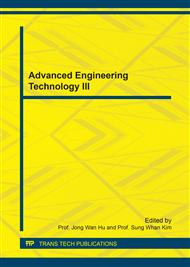[1]
Z. Zhang, A flexible new technique for camera calibration, IEEE Trans. Pattern Anal. Mach. Intell. 22(11) (2000) 1330-1334.
DOI: 10.1109/34.888718
Google Scholar
[2]
J. Park, Multi-view 3d object reconstruction using coordinate transformation, Appl. Mech. Mater. 284-287 (2013) 2167-2170.
DOI: 10.4028/www.scientific.net/amm.284-287.2167
Google Scholar
[3]
J. Park, Volumetric model body outline computation for an object tracking in a video stream, Appl. Mech. Mater. 479-480 (2013) 897-900.
DOI: 10.4028/www.scientific.net/amm.479-480.897
Google Scholar
[4]
J. Park, S. Park, Improvement on zhang's camera calibration, Appl. Mech. Mater. 479-480 (2013) 170-173.
Google Scholar
[5]
R. Hartley, A. Zisserman, Multiple View Geometry in Computer Vision, Cambridge University Press, 2nd., (2004).
Google Scholar
[6]
T. Moons, L. van Gool, M. Vergauwen, 3d reconstruction from multiple images, part I: Principles, Foundation and Trends in Computer Graphics and Vision, 4 (2008), 287-404.
DOI: 10.1561/0600000007
Google Scholar
[7]
S. Seitz, C. Dyer, Photorealistic scene reconstruction by voxel coloring, IJCV, 35 (1999) 151-173.
Google Scholar
[8]
T. Fromherz, M. Bichsel, Shape from multiple cues: Integrating local brightness information, in ICYCS, (1995).
Google Scholar
[9]
O. Faugeras, E. Bras-Mehlman, J. D. Boissonnat, Representing stereo data with the delaunay triangulation, Artif. Intell. 44(1-2) (1990) 41-87.
DOI: 10.1016/0004-3702(90)90098-k
Google Scholar
[10]
A. Laurentini, The visual hull concept for silhouette-based image understanding, IEEE Trans. PAMI, 16(2) (1994) 150-162.
DOI: 10.1109/34.273735
Google Scholar
[11]
C. Choi, H. I. Christensen, Robust 3d visual tracking using particle ltering on the special euclidean group: A combined approach of keypoint and edge features, Int. J. Robot Res. 31 (2012) 498-519.
DOI: 10.1177/0278364912437213
Google Scholar
[12]
T. Drummond, R. Cipolla, Real-time visual tracking of complex structures, IEEE PAMI, 24(7) (2002) 932-946.
DOI: 10.1109/tpami.2002.1017620
Google Scholar
[13]
J. Park, 3D mosaic from images, Appl. Mech. Mater. 752-753 (2015) 1081-1084.
Google Scholar
[14]
J. Park, Object movement computation from two images, Appl. Mech. Mater. 752-753 (2015) 1085-1089.
DOI: 10.4028/www.scientific.net/amm.752-753.1085
Google Scholar
[15]
V. Prisacariu, I. Reid, Pwp3d: Real-time segmentation and tracking of 3d objects, Int. J. Comput. Vis. 98(3) (2012) 335-354.
DOI: 10.1007/s11263-011-0514-3
Google Scholar
[16]
H. T. Nguyen, M. Worring, R. van den Boomgaard, A. W. M. Smeulders, Tracking nonparameterized object contours in video, IEEE Trans. Image Process. 11(9) (2002) 1081-1091.
DOI: 10.1109/tip.2002.802522
Google Scholar
[17]
J. Park, T. Kim, S. Park, Level-of-detail canny edge based routing for object contour tracking, 17th International Conference on Computer Animation and Social Agents, 2004, pp.339-346.
Google Scholar
[18]
M. Roh, T. Kim, J. Park, S. Lee, Accurate object contour tracking based on boundary edge selection, Patt. Recognit. 40(3) (2007) 931-943.
DOI: 10.1016/j.patcog.2006.06.014
Google Scholar
[19]
L. S. Lasdon, A. D. Warren, A. Jain, M. Ratner, Design and testing of a generalized reduced gradient code for nonlinear programming, ACM Trans. Math. Software, 4 (1978) 34-50.
DOI: 10.1145/355769.355773
Google Scholar


